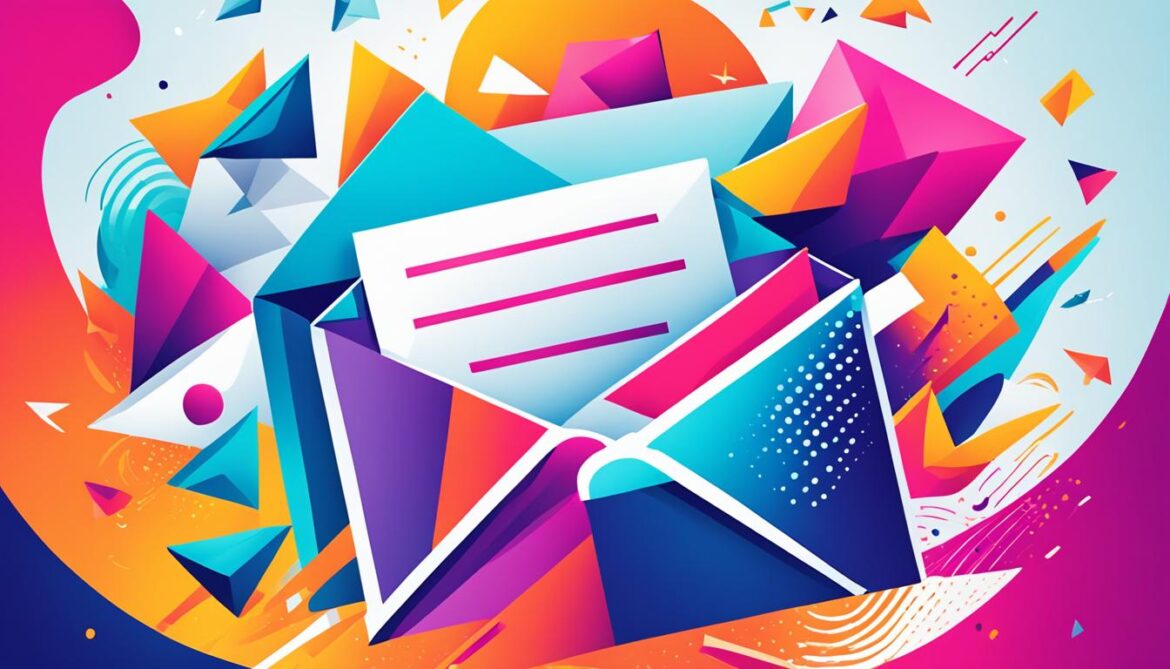In the digital age, an email can serve as the initial handshake in professional contexts, making it pivotal to ensure that these virtual introductions set a positive tone for future interactions. Our comprehensive email introduction guide is designed to equip you with the tools to make a great first impression, thereby laying the foundation for successful and productive relationships.
The ability to make a great first impression through email is more than just a courtesy; it’s a strategic advantage in today’s fast-paced business environment. By adhering to key principles and utilizing best practices, you can create email introductions that not only resonate with the recipient but also reflect your professionalism and attention to detail.
Key Takeaways
- Understanding and mastering the nuances of email introductions can significantly impact business relationships.
- A great first impression is essential to build trust and credibility from the onset.
- Email introduction guidelines focus on clarity, personalization, and crafting a positive narrative.
- This guide provides actionable tips for creating meaningful and impactful email communications.
- Effective email introductions are not just about words; they’re about creating connections.
The Art of Crafting Compelling Email Introductions
The initial venture into any professional relationship often begins with an email, making the mastery of crafting compelling email introductions an essential skill in today’s digital age. A well-crafted introduction serves not merely as a preliminary handshake but as a definitive gesture to earn trust, showcase professionalism, and signal the value that the ensuing conversation could bring to both parties involved.
When considering how to engage your recipient, a compelling email introduction ticks several critical boxes. It should exude clarity, immersing the reader in the crux of the message without unnecessary detours; it should inject a dose of personalization to resonate with and speak directly to your audience; and above all, it should encapsulate a clear purpose, ensuring that the recipient understands the why of your outreach right from the get-go.
“First impressions last,” holds exceedingly true when it comes to email. The initial few lines can often dictate the tone and trajectory of your professional relationship.
- Clarity is key: A succinct and on-point introduction sets the stage.
- Personal touch: Addressing the recipient by name can weave an instant thread of connection.
- Purpose-driven narrative: Stating the intent of your email provides clear direction for the recipient’s response.
Consider in equal measure the nuances that envelop the core of an email introduction. An understanding of the recipient’s background and tailoring your message to their field or interests could be the distinction between a generic message and one that genuinely captivates.
| Component | Description | Benefit |
|---|---|---|
| Subject Line | Curiosity-inducing, concise, relevant | Captures attention, invites opening |
| Greeting | Personalized, respectful | Establishes rapport, signals courtesy |
| Opening Line | Engaging, purposeful | Delineates intent, promotes reader interest |
| Body Content | Informative, concise, value-driven | Communicates message, builds credibility |
| Closing | Clear call-to-action, courteous sign-off | Invites engagement, leaves a positive impression |
Implementing these components harmoniously into your introduction can set a professional cadence. To tread the path of crafting compelling email introductions with finesse, remember that each email is not just a message but an opportunity to embark on meaningful professional journeys.
How to Introduce Yourself in an Email
Mastering the initial email introduction sets the stage for a professional relationship and reflects your communication skills. Whether you are networking, applying for a job, or initiating a business proposition, understanding how to introduce yourself in an email is essential. Here are concrete email introduction tips to ensure you make a stellar first impression.
Choosing the Right Subject Line
The subject line acts as the headline to your email—coveted real estate that can determine whether your message gets opened or overlooked. It should be relevant, succinct, and hint at the value the recipient will gain from reading more. Consider including a mutual connection or specific topic of interest to increase the likelihood of your email being read.
Constructing a Persuasive Opening
Once your email is opened, captivate your reader with a persuasive opening. Begin with a respectful greeting followed by an engaging statement or question related to your recipient’s interests or industry. This approach underscores the personalized nature of your message and forms an immediate connection, which is crucial in email introduction etiquette.
Introducing Yourself Clearly and Concisely
Now it’s time to spotlight yourself. Briefly outline who you are, focusing on aspects most relevant to the recipient. Whether it’s your current role, expertise, or a shared interest, ensure that you showcase your value proposition. Remember, the goal is not to tell your entire professional story but to provide a snapshot that resonates with your audience and serves as a prompt for further discussion.
| Element | Description | Example |
|---|---|---|
| Subject Line | Engages interest and implies content | “Connecting Over Shared Passion for Renewable Energy” |
| Opening Line | Personalized statement or question | “I was thrilled to see your latest project on sustainable architecture featured in Green Build Magazine…” |
| Self-Introduction | Brief and relevant professional snapshot | “As a sustainability advocate with a focus on green building, I’ve admired your work for some time…” |
By following these steps not only do you learn how to introduce yourself in an email effectively, but you also lay the groundwork for meaningful dialogues. Keep refining your approach with practical email introduction tips and watch as your professional network expands.
Personalization: The Key to a Memorable Email Introduction
In the realm of digital communication, particularly when constructing email introductions, personalization plays an instrumental role in fostering genuine connections. By incorporating personalization in email introductions, senders express their interest and attentiveness towards the recipient, thereby laying the groundwork for a rapport that extends beyond a mere transactional exchange. This practice not only resonates with the recipient on an individual level but also significantly increases the probability of a continued engagement.
Optimizing personalization in email introductions is not about grand gestures; subtle inclusions bespoke to the recipient can make a profound impact. The essence lies in the details—using the recipient’s name, mentioning a recent event they organized, or even acknowledging their professional contributions. Such tailored approaches in crafting an opening correspondence can spell the difference between a forgettable email and an introduction that paves the way for a meaningful interaction.
- Identify key elements within the recipient’s professional arena to illustrate that the message is crafted for them uniquely, demonstrating that you have taken the time to understand their role and industry.
- Reference shared interests or mutual connections, as these points of commonality can bridge the initial gap between stranger and acquaintance, enriching the opening dialogue with warmth and familiarity.
- Modulate the language and tone to resonate with the individual’s preferences, whether they favor a more formal tone or a conversational cadence that reflects approachability and informality.
Foremost, the goal of personalization is to establish that the email is not a pre-fabricated template, dispersed indiscriminately. It is crucial to convey that the recipient is not merely a number in a mass-email campaign. Personalization in email introductions should embody the ethos that behind every email address lies an individual with their unique set of experiences, perspectives, and aspirations. Modifying one’s approach to respect and reflect these nuances is what underpins personalization in this sphere.
| Strategy | Description | Benefits |
|---|---|---|
| Use of Recipient’s Name | Starting emails with a direct address using the recipient’s own name. | Heightens attention and fosters a sense of acknowledgement. |
| Tailored Content | Content is altered based on the recipient’s interests, job role, or recent activities. | Increases relevance and makes the recipient feel seen and understood. |
| Shared Interest Highlight | Mention personal or professional interests that overlap with the recipient’s interests. | Serves as a starting point for rapport building and potential collaboration. |
Remember, when it comes to personalization in email introductions, it’s not merely about standing out in an inbox—it’s about fostering a feeling of recognition and value from the very first interaction.
Email Introduction Tips: From Salutations to Sign-Offs
Mastering the nuances of email introduction etiquette is essential for making a polished first impression in the digital realm. Whether you’re initiating a new professional relationship or reaching out for a collaborative opportunity, the right approach to your email can set the tone for all future interactions. This section is dedicated to providing actionable email introduction tips that will help you communicate with confidence and courtesy.
Appropriate Greetings for Different Contexts
The right salutation depends on the familiarity and formality of the situation. For formal business contexts, classic greetings such as “Dear [Title] [Last Name],” are preferred. In contrast, if you’ve met the recipient in a more casual setting, a simple “Hello [First Name],” can make the email feel personal and warm. Recognizing the appropriateness of the greeting sets the stage for a respectful rapport.
Body Content: Balancing Brevity and Information
Conveying your message with conciseness while providing sufficient information is a balancing act. The body of the email should be direct and to the point, but also include enough context so the recipient understands the purpose of your email without needing to ask for more details. Aim for clarity and relevance to maintain the recipient’s attention and avoid unnecessary back-and-forths.
Polished Signatures and Contact Details
Your email sign-off is just as crucial as your introduction; it should reflect the same level of professionalism and consideration. A thoughtful signature, with a simple “Best regards,” or “Sincerely,” followed by your full name, title, and contact details, enables easy follow-ups and demonstrates thorough email introduction etiquette. Remember to include all necessary information, but keep it succinct to respect the recipient’s time.
Email Introduction Etiquette: Do’s and Don’ts
Mastering the art of email introduction etiquette is crucial in a world where first impressions are often made digitally. In this section, we aim to distill the essence of etiquette into practical do’s and don’ts for crafting respectful and professional email introductions.
When extending a digital handshake, the do’s of email introduction etiquette involve more than polite language. It begins with understanding the context and respecting the recipient’s time. On the flip side, the don’ts are pitfalls that can undermine your intended message, be it due to tone mishaps or overlooking cultural nuances.
- Do: Use a clear and relevant subject line. It’s the first thing the recipient sees, so make sure it accurately reflects the content of the email.
- Do: Address the recipient by name. It’s a simple act that personalizes the conversation and is a cornerstone of proper email introduction etiquette.
- Do: Keep your message concise yet informative. It demonstrates respect for the recipient’s busy schedule.
- Don’t: Use slang or overly casual language, which may come off as unprofessional.
- Don’t: Overlook proofreading. Grammatical mistakes or typos can easily be perceived as carelessness.
- Don’t: Ignore cultural differences. If you’re reaching out to someone from another country, a little research into communication norms can go a long way.
Furthermore, in the spirit of email introduction etiquette, always consider the timing of your message. Being mindful of the recipient’s time zone and their probable working hours reflects thoughtfulness.
“In the world of email communications, etiquette isn’t just a courtesy, it’s the fabric of first impressions and lasting connections.”
Regardless of the industry, role, or intention behind the email, upholding the highest standards of email introduction etiquette will serve as a testament to your professionalism, attentiveness, and respect for the recipient.
Techniques for Cultivating Instant Connection in Emails
Mastering the art of email correspondence is crucial, especially when we aim to establish a rapport with our recipients right from the start. By focusing on cultivating connection in email introductions, we can bridge the virtual gap and forge meaningful relationships swiftly. Let’s delve into some proven techniques that can help make your email introductions more engaging and personal.
Mentioning Shared Interests or Connections
One way to immediately resonate with your audience is to bring shared interests or connections into the conversation. This common ground not only humanizes the interaction but also serves as a solid foundation for ongoing dialogue. Consider the following tactics:
- Research the recipient’s professional background and interests.
- Reference any mutual connections or colleagues.
- Discuss commonalities in hobbies, projects, or industry insights.
Not only does this strategy demonstrate your attention to detail, but it helps in engaging email introductions that feel personalized and thoughtful.
Utilizing Humor and Personal Anecdotes
Injecting a bit of humor or sharing a personal anecdote can be a breath of fresh air in a world cluttered with generic emails. When done tastefully, it can instantly warm up the recipient to your message. However, it’s crucial to consider the context and the recipient’s preferences or company culture to ensure your attempt at humor is appropriate and well-received.
End with an Engaging Question or Call to Action
Leaving the recipient with an engaging question or a call to action can motivate a response and initiate a conversation. This could range from seeking their opinion on a relevant topic to inviting them to participate in a forthcoming event. Signing off with a purpose encourages the recipient to engage further, thus fostering a connection almost instantaneously.

| Technique | Description | Purpose |
|---|---|---|
| Mentioning Shared Interests | Finding and referencing common ground in interests or connections. | To personalize the introduction and create a sense of camaraderie. |
| Humor and Anecdotes | Including a tasteful joke or personal story related to the email’s context. | To engage the recipient on a more human level, making the email memorable. |
| Question/Call to Action | Ending with a thought-provoking question or a clear next step. | To encourage a response, maintaining the flow of conversation. |
As we explore these strategies, it is imperative to ensure that cultivating connection in email introductions remains a genuine effort rather than a mechanical process. Genuine connection is built when the recipient feels valued as an individual, and these techniques are merely instruments to convey that sentiment in your digital communications.
Why First Impressions Through Email Matter
Understanding the importance of email impressions is pivotal in the digital age, where a substantial amount of professional communication is conveyed electronically. The initial contact via email can either open doors to new opportunities or close them. Much like a digital handshake, first impressions in email are a critical opportunity to project professionalism, warmth, and competence.
An email introduction may seem like a small component of your professional communication, but it holds immense power in shaping how you’re perceived. The nature of digital communication underscores the importance of getting it right the first time; unlike face-to-face interactions, email doesn’t provide a second chance to correct a first impression that isn’t favorable.
| Positive Email Impression | Negative Email Impression |
|---|---|
| Builds anticipation and interest | May lead to a loss of interest or misunderstanding |
| Cultivates credibility and trust | Can project incompetence or disrespect |
| Encourages reciprocation and engagement | Decreases the likelihood of a prompt response |
| Forms the foundation for ongoing communication | Creates barriers to future interaction |
When you master first impressions in email, you craft a narrative about who you are and what you represent. A compelling email introduction resonates with the recipient, nurturing a professional relationship right from the onset.
Incorporating a personalized approach reflects attention to detail and shows a genuine interest in the recipient as an individual, not just a business opportunity. This can be as simple as mentioning a recent accomplishment of theirs you admire or referencing a mutual contact.
To reiterate, first impressions in email are not merely about using the right words but also about evoking the right feelings. They serve as the cornerstone for perceived professionalism and play a crucial role in the development of successful professional relationships.
Best Email Introduction Examples: What Works and Why
Understanding the elements that contribute to the effectiveness of an email introduction is crucial for anyone looking to make a memorable first impression. Below, we’ve compiled some of the best email introduction examples, pinpointing the attributes that drive their success. Whether used in networking endeavors, job applications, or forging business partnerships, these snippets serve as a gold standard for crafting introductions that yield positive responses.
Let’s dissect these best email introduction examples to reveal why they stand out:
- An emphasis on brevity coupled with necessary details makes the introduction concise yet complete.
- The inclusion of a personalized touch demonstrates attentiveness and research on the sender’s part.
- A clear statement of intent informs the recipient of the email’s purpose right from the outset.
- Closing with a call to action or question paves the way for dialogue and further engagement.
Evaluating these aspects across various scenarios allows us to extract lessons that can be applied to any introduction email. The following table presents best email introduction examples with a breakdown of their effective components:
| Scenario | Key Components | Why it Works |
|---|---|---|
| Networking | Brevity, personalized mention of a shared connection, a clear networking ask | Creates an immediate sense of camaraderie and a straightforward path to collaboration |
| Job Application | Brief mention of qualifications, expressed enthusiasm for the role, direct reference to the job listing | Shows a tailored approach and eagerness, aligning the candidate’s goals with the company’s needs |
| Business Partnership | Identification of mutual benefits, professional tone, invitation for a meeting or discussion | Asserts the potential value add, setting a serious yet collaborative tone for partnership discussions |
In the case of networking, a powerful introduction might start with recognizing a mutual acquaintance or an event both parties attended. For job applications, citing specific alignment with the role’s requirements can showcase informed interest. In business partnerships, clarity about mutual gains suggests a vision for future success. Each scenario has distinct nuances, but the underpinning principles of crafting the best email introduction examples remain clear: be brief, personal, and purposeful.
Lastly, remember that your email serves as a precursor to the personality and professionalism you bring to the table. These best email introduction examples are not just templates; they’re a reflection of thoughtful strategy and end-to-end consideration of the recipient’s perspective.
Creating a Professional Email Template for Various Scenarios
In today’s fast-paced digital landscape, crafting a professional email template is essential for effective communication across a broad range of contexts. Whether you’re reaching out to a new business connection, applying for a job, or simply networking, having a versatile email template for different scenarios can save time while ensuring consistency and professionalism. A well-structured template acts as a scaffold, enabling you to personalize your message without starting from scratch every time. In this guide, we’ll walk through the essential components of an email template that can be adjusted to fit various professional situations, maintaining a balance between standardization and customization.
Starting with the subject line, an impactful template must capture attention and convey the email’s purpose succinctly. The subject line primes the recipient for the content within, setting the tone for the interaction. In the introduction, briefly introduce yourself, state the reason for reaching out, and where appropriate, mention how you came across the recipient’s information. As we weave through the body content, clarity and brevity are paramount. Layout the key points you wish to communicate, providing enough context to be informative but concise enough to respect the recipient’s time. Lastly, the closing should reiterate the goal of the email, include a courteous sign-off, and provide clear contact details for follow-up actions.
When creating a professional email template, it’s crucial to personalize elements to align with the recipient’s industry, position, and the nature of your interaction. A one-size-fits-all approach lacks the personal touch necessary for building connections. Instead, tailor the core structure to reflect the recipient’s company culture, the urgency of your message, or the specifics of your request. By mastering the craft of a professional email template, you improve not only your efficiency but also the likelihood of forging successful and lasting professional relationships.
FAQ
What is the importance of crafting compelling email introductions?
Crafting compelling email introductions is important because it can capture the recipient’s attention, establish credibility, and pave the way for a successful professional relationship.
How can I introduce myself in an email effectively?
To introduce yourself effectively in an email, start by choosing the right subject line to grab the recipient’s attention. Then construct a persuasive opening that engages the reader. Introduce yourself clearly and concisely, highlighting your key qualifications and purpose for reaching out.
How can I personalize my email introductions?
To personalize your email introductions, use the recipient’s name, reference shared interests or connections, and customize the message to fit the recipient’s needs or preferences.
What are some essential tips for crafting effective email introductions?
Some essential tips for crafting effective email introductions include using appropriate greetings for different contexts, striking the right balance between brevity and providing relevant information in the body of the email, and including polished signatures and contact details for easy follow-up.
What email introduction etiquette should I follow?
To follow email introduction etiquette, use a professional tone, avoid grammatical errors, and be mindful of cultural differences. Maintain professionalism and respect in your email introductions.
How can I cultivate an instant connection through email introductions?
To cultivate an instant connection through email introductions, mention shared interests or connections to establish common ground. Utilize humor and personal anecdotes to make the email more engaging and relatable. End the email with an engaging question or call to action to encourage further interaction.
Why do first impressions through email matter?
First impressions through email matter because they set the tone for future interactions and can influence the recipient’s perception of professionalism, credibility, and trustworthiness.
Can you provide some examples of great email introductions?
Yes, in this guide, we have compiled the best email introduction examples for different scenarios, such as networking, job applications, and business partnerships. These examples demonstrate what makes them effective in creating a great first impression.
How can I create a professional email template for different scenarios?
To create a professional email template for different scenarios, structure the template with the subject line, introduction, body content, and closing. Customize the template for each recipient and scenario, while maintaining consistency in your communication.







